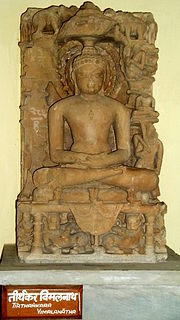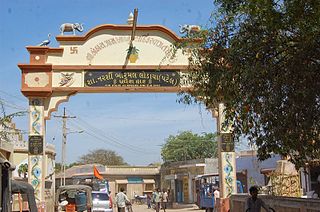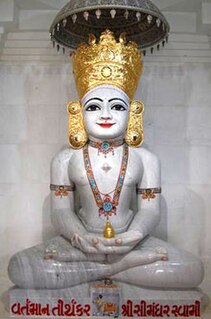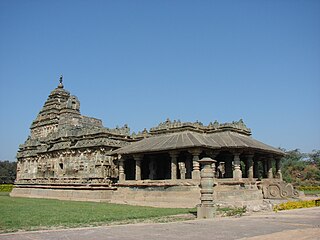
Shri Sammed Shikharji is a pilgrimage site in Giridih district, Jharkhand, India. It is located on Parasnath hill, the highest mountain in the state of Jharkhand. It is the most important Jain Tirtha by both Digambara and Śvētāmbara, for it is the place where twenty of the twenty-four Jain tirthankaras along with many other monks attained Moksha.

Shankheshwar is a town in the Patan district of Gujarat state of India. It is an important place of pilgrimage for the followers of Jainism.

A Jain temple or Derasar is the place of worship for Jains, the followers of Jainism. Jain architecture is essentially restricted to temples and monasteries, and Jain buildings generally reflect the prevailing style of the place and time they were built.

Suparshvanatha, also known as Suparśva, was the seventh Jain Tīrthankara of the present age (avasarpini). He was born to King Pratistha and Queen Prithvi at Varanasi on 12 Jestha Shukla in the Ikshvaku clan. He is said to have attained moksha at Shikharji on the sixth day of the dark half of the month of Phālguna.

Vimalanatha was the thirteenth Jain Tirthankara of the present age (Avasarpini). According to Jain beliefs, he became a Siddha, a liberated soul which has destroyed all of its karma. Vimalanatha was born to King Kratavarma and Queen Shyamadevi at Kampilya of the Ikshvaku dynasty. His birth date was the third day of the Magh Sukla month of the Indian calendar.

Mallinatha was the 19th tīrthaṅkara "ford-maker" of the present avasarpiṇī age in Jainism. Jain texts indicate Mālliṇātha was born at Mithila into the Ikshvaku dynasty to King Kumbha and Queen Prajnavati. Tīrthaṅkara Māllīnātha lived for over 56,000 years, out of which 54,800 years less six days, was with omniscience.

Munisuvratanatha was the twentieth Tirthankara of the present half time cycle (avasarpini) in Jain cosmology. He became a siddha, a liberated soul which has destroyed all of his karma. Events of the Jaina version of Ramayana are placed at the time of Munisuvratanatha. Munisuvratanatha lived for over 30,000 years. His chief apostle (gaṇadhara) was sage Malli Svāmi.

In Jainism, Ambika or Ambika Devi is the Yakṣi "dedicated attendant deity" or Śāsana Devī "protector goddess" of the 22nd Tirthankara, Neminatha. She is also known as Ambai, Amba, Kushmandini and Amra Kushmandini. She is often shown with one or more children and often under a tree. She is frequently represented as a pair with a small Tirthankar image on the top. The name ambika literally means mother, hence she is Mother Goddess. The name is also a common epithet of Hindu Goddess Parvati.

Jainism in North Karnataka flourished under the Chalukyas, Kadamba, Rashtrakutas, and Vijayanagara empire. Imbued with religious feeling, patronage was extended towards the building of Jain temple and it garnered high repute among the people, particularly the ruling classes and the mercantile community; effectively getting treated as the state religion.

Shri Mahavir Ji is an important Jain pilgrimage site situated in Shri Mahaveerji town in Hindaun Block, Karauli district in Rajasthan. Given the importance of the religious place, the Indian Railways has specifically developed a railway station under West Central Railway zone by the name of Shri Mahaveerji railway station which is 10 minutes drive from the temple and temple authorities have arranged for regular buses from station to the temple. The temple is visited by millions of Jain and Hindu devotees every year.

Kothara is a village and a Jain pilgrimage center located in Abdasa Taluka of Kutch district of Gujarat, India.

Tirumalai (lit. "the holy mountain"; also later Arhasugiri, lit. "the excellent mountain of the Arha[t]"; Tamil Engunavirai-Tirumalai, lit. "the holy mountain of the Arhar" is a Jain temple and cave complex dating from at least the 9th century that is located northwest of Polur in Tamil Nadu, southeast India. The complex includes 3 Jain caves, 2 Jain temples and a 16.25-foot-high sculpture of Tirthankara Neminatha thought to date from the 12th century that is the tallest Jain image in Tamil Nadu. Arahanthgiri Jain Math is also present near Tirumalai complex.

Godiji Parshwanath is the name given to several images of the Jain Tirthankar Parshwananth in India, and to the temple where it is the main deity (mulanayaka). Parshwanath was the 23rd Tirthankara who attained nirvana in 777 BCE.

Simandhara is a Tīrthaṅkara, an arihant, who is said to be currently living in another world in the Jain cosmological universe.

The Palitana temples are the large groups of Jain temples located on Shatrunjaya hills near Palitana in Bhavnagar district, Gujarat, India. Also known as Padliptapur of Kathiawad in historic texts, the dense collection of over 800 small shrines and large temples here has led many to call Palitana as a "city of Temples". It is one of the most sacred sites of Svetambara tradition within Jainism. These temples were built in and after the 11th-century CE.

Jainism is an Indian religion which is traditionally believed to be propagated by twenty-four spiritual teachers known as tirthankara. Broadly, Jainism is divided into two major schools of thought, Digambara and Svetambara. These are further divided into different sub-sects and traditions. While there are differences in practices, the core philosophy and main principles of each sect is the same.

Jain art refers to religious works of art associated with Jainism. Even though Jainism has spread only in some parts of India, it has made a significant contribution to Indian art and architecture.

The Brahma Jinalaya, sometimes called as the Greater Jain Temple of Lakkundi, is an early 11th-century Mahavira temple in Lakkundi, Gadag District of Karnataka state, India. The temple is attributed to Attiyabbe, the wife of the local governor Dandanayaka Nagadeva. It faces east, has a mukhamandapa, a gudhamandapa and its sanctum is covered by a sur-temple style vimana superstructure. The temple is notable for its reliefs depicting Jaina artwork, statues of the Tirthankaras and the two Hindu statues of Brahma and Saraswati inside its inner mandapa.

Aranath was the eighteenth Jain Tirthankar of the present half cycle of time (Avasarpini). He was also the eighth Chakravartin and thirteenth Kamadeva. According to Jain beliefs, he was born around 16,585,000 BCE. He became a siddha i.e. a liberated soul which has destroyed all of its karmas. Aranath was born to King Sudarshana and Queen Devi (Mitra) at Hastinapur in the Ikshvaku dynasty. His birth date was the tenth day of the Migsar Krishna month of the Indian calendar.

The Lakshmeshwara Jain temples is a group of Jain temples in the town of Lakshmeshwara in the Gadag district of Karnataka.




















